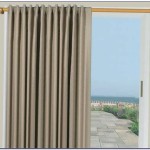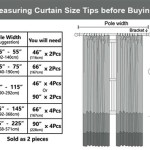Should Curtains Go To The Ceiling? An Exploration of Design, Functionality, and Aesthetics
The placement of curtains often extends beyond a simple functional decision to block light or provide privacy. It becomes an integral aspect of interior design, influencing the perceived proportions of a room, enhancing the overall aesthetic, and contributing to the atmosphere. One specific design consideration revolves around the vertical placement of curtains: specifically, whether they should extend from the ceiling down to the floor. This design choice presents a range of advantages and disadvantages that warrant careful evaluation based on the specific characteristics of the space and the desired outcome.
Traditional curtain placement often involves hanging curtain rods a few inches above the window frame. However, extending the curtain rod to the ceiling offers a potentially transformative effect, capable of altering the perceived dimensions of a room and creating a sense of grandeur. This approach has gained popularity among interior designers and homeowners seeking to maximize vertical space and create a more visually impactful interior. The decision, however, is not universally applicable and requires a nuanced understanding of the room's architecture, lighting, and existing decor.
Creating the Illusion of Height and Space
One of the most compelling arguments for hanging curtains from the ceiling is its ability to visually elongate the walls. By drawing the eye upward, the curtains create the illusion of a taller and more spacious room. This is particularly beneficial in rooms with lower ceilings, where the added vertical emphasis can significantly improve the sense of openness. The continuous line from ceiling to floor eliminates visual breaks, making the wall appear unbroken and extending the perceived height of the space. The longer the curtains, the greater the visual impact and feeling of spaciousness.
The effect is enhanced when the curtain fabric is carefully chosen to further contribute to the illusion of height. Vertical stripes or patterns, for example, will accentuate the verticality created by the extended curtain placement. Conversely, horizontal patterns may detract from the intended effect. The color also plays a crucial role. Lighter colors tend to reflect more light, further enhancing the feeling of spaciousness, while darker colors can absorb light and potentially make the room feel smaller, although they can still create a dramatic and sophisticated look.
Furthermore, the choice of curtain hardware can contribute to the overall illusion. Sleek, minimalist rods and finials will maintain the clean lines and avoid unnecessary visual clutter that could interrupt the upward visual flow. The rod should be substantial enough to support the weight of the curtains and extend beyond the window frame to allow for a full and unobstructed view when the curtains are open.
Enhanced Ambiance and Light Control
Beyond simply creating the illusion of height, ceiling-to-floor curtains can significantly enhance the ambiance of a room and provide superior light control. When closed, these curtains act as a substantial barrier against incoming light, creating a darker and more intimate atmosphere. This can be particularly beneficial in bedrooms where a darkened environment is conducive to sleep, or in home theaters where minimizing glare is essential for optimal viewing. The added layer of fabric also contributes to sound dampening, further enhancing the sense of privacy and tranquility.
The ability to precisely control the amount of light entering a room is a significant advantage. By adjusting the curtains, one can filter the light to create the desired level of brightness and warmth. Sheer curtains, when hung from the ceiling, can diffuse natural light and create a soft, glowing effect, while heavier, blackout curtains can completely block out light. The combination of different curtain types allows for maximum flexibility in controlling the ambiance of the room.
Moreover, the fabric choice influences the overall feel of the room. Linen, for example, offers a relaxed and natural vibe, while velvet exudes luxury and sophistication. The texture and weight of the fabric contribute to the overall tactile experience of the room. By carefully selecting the fabric, one can tailor the ambiance of the room to reflect personal preferences and style.
Addressing Practical Considerations and Potential Drawbacks
While the aesthetic and functional benefits of hanging curtains from the ceiling are undeniable, certain practical considerations and potential drawbacks must be addressed. One of the primary concerns is the cost. Extending the curtain rod to the ceiling typically requires a longer rod and potentially custom-made curtains, which can increase the overall expense. The fabric choice also plays a significant role in the cost; premium fabrics such as silk or velvet will naturally be more expensive than synthetic alternatives.
Another practical consideration is the installation process. Installing a curtain rod directly into the ceiling requires careful planning and execution. The ceiling’s structural integrity must be assessed to ensure it can support the weight of the rod and curtains. In some cases, reinforcement may be necessary to prevent the rod from pulling away from the ceiling over time. Furthermore, accurate measurements are crucial to ensure the curtains hang correctly and reach the floor without dragging or being too short.
Finally, the cleaning and maintenance of floor-length curtains can be more demanding than shorter curtains. They are more susceptible to collecting dust and dirt from the floor, requiring regular vacuuming or cleaning. The fabric type will dictate the appropriate cleaning method; some fabrics may require professional cleaning to avoid damage. Pet owners should also consider the potential for pet hair and dander to accumulate on the curtains, requiring more frequent cleaning.
Beyond these practical aspects, there are design considerations that must be taken into account. The style of the room, the height of the ceiling, and the size of the windows should all influence the decision to hang curtains from the ceiling. In rooms with very low ceilings, the effect may be less dramatic, and in some cases, it may even feel overwhelming. Similarly, in rooms with extremely tall ceilings, floor-length curtains may not be sufficient to achieve the desired effect. The scale and proportion of the curtains should be carefully considered to ensure they complement the overall design of the room.
Ultimately, the decision to hang curtains from the ceiling is a matter of personal preference and a careful assessment of the specific characteristics of the space. While the technique offers the potential to create a more spacious, elegant, and functional interior, it is essential to weigh the benefits against the practical considerations and potential drawbacks. Proper planning, careful execution, and a keen eye for design are essential to achieving the desired outcome.
The style of the room should also inform the decision. A minimalist aesthetic might benefit from simple, unadorned curtains that blend seamlessly with the wall, while a more traditional room might call for heavier, more ornate drapes. The existing furniture and accessories should also be taken into account. The curtains should complement the overall color scheme and style of the room, creating a cohesive and harmonious look.
In conclusion, the strategic placement of curtains, including the decision to extend them from ceiling to floor, is a powerful tool in interior design. It offers a pathway to manipulate the perception of space, control light, and enhance the overall aesthetic of a room. By carefully considering the architectural context, practical considerations, and individual preferences, one can effectively leverage this technique to create a more beautiful and functional living environment. The key lies in understanding the nuances of design and tailoring the approach to the specific needs and desires of the space.

Hanging Curtains You Re Probably Doing It Wrong Ask The Expert Style Boston Com Real Estate
.jpg?strip=all)
Why You Should Hang Curtains Higher Dream Green Diy

The One Thing You Must Change In Your Home Decorologist

How To Hang Curtains Look Their Best The Shade

How To Hang Curtains Like A Pro Diy Darling

Why You Should Hang Curtains Higher Dream Green Diy

How To Hang Curtains Simple Tips For A Bigger And Brighter Room

How To Hang Curtains The Right Way Painting By Penny
.jpg?strip=all)
Why You Should Hang Curtains Higher Dream Green Diy

Should Curtains Go On Wall Or Ceiling








